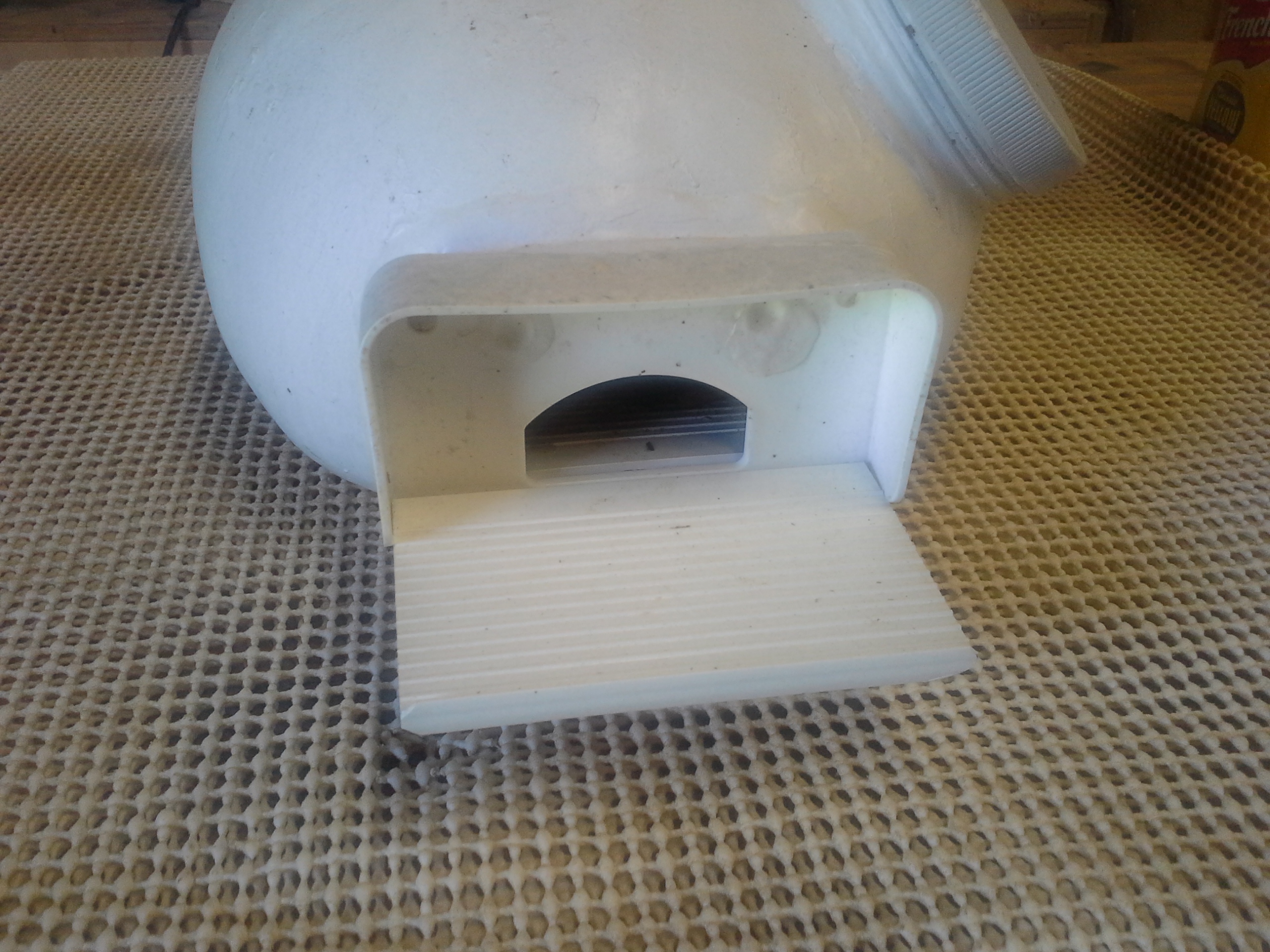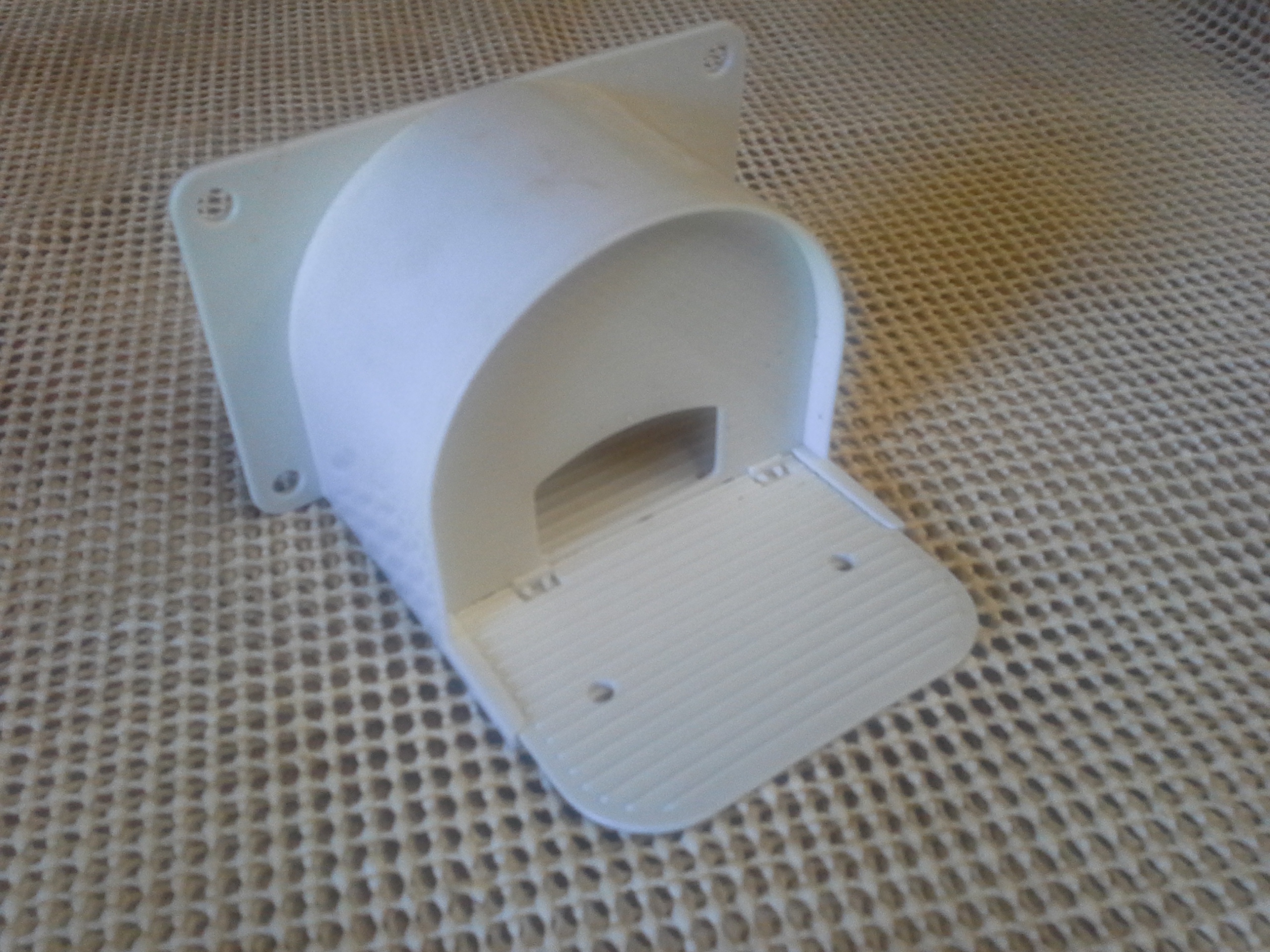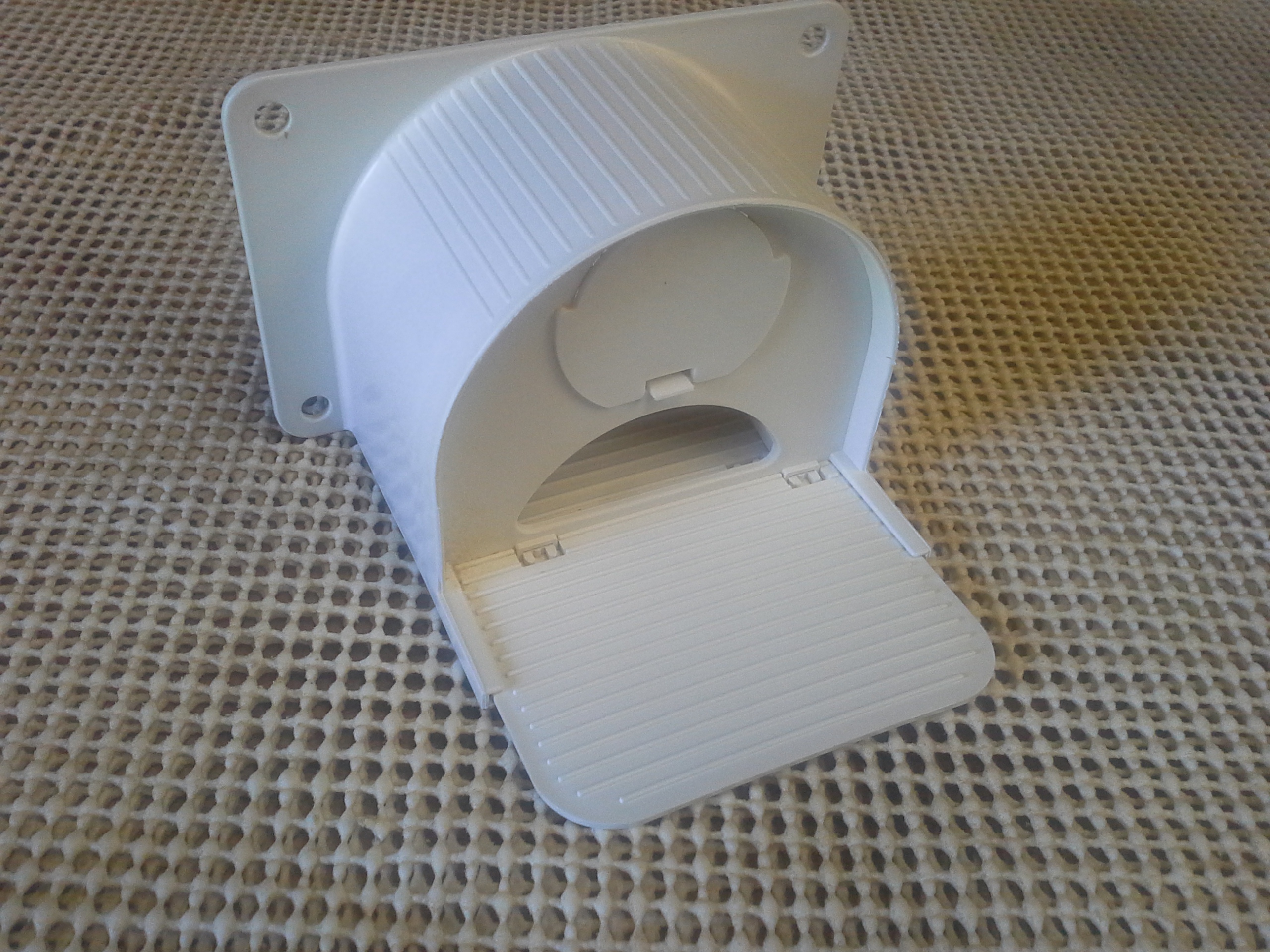
SREH
Entrances
I've been asked a number of different times about SREH (Starling Resistant Entrance Hole) entrances. What's the best, do they really work, etc? Well, on this page, we'll explore various entrances that are used/available for purple martins.
Some history:
First, there's the ole' ROUND hole. This hole style has been around for years, literally. It was the very first entrance hole used by early purple martin landlords. They witnessed martins going in and out of them, measured them and that's how the 2" came about. And yes, they are still used today. They've been around for ages, are plenty big enough for purple martins to get in and so that's what's used.
However; that round hole style is quickly becoming obsolete and are being replaced by SREH entrance holes. The reason; European Starlings. Starlings have become very abundant in the US and Canada and in fact, have become a scourge to purple martin landlords across the country. They are also cavity nesters and can get in these 2" holes just as easily as martins and if that happens, your martin house will quickly be taken over by them and your martins will not be allowed to nest. Starlings are known to kill martins if they can trap them in their compartments and thus, round holes just aren't the style of hole to use anymore.
Second, there's the new SREH entrance holes. Now let me state, there are a number of different styles available. Once the original Crescent version came available and was found to work well for keeping starlings out of martin housing, other martin landlords investigated and decided to see if they could come up with one of their own that worked, and I have to say, there are a number of them. On this page, we'll investigate the top ones, simply because I have experience in using them and have my own take on them.
1 - The Oblong, sorry, I don't know who came up with it. However, because it was quickly breached by starlings, (even more than the Crescent available at the time) it was quickly dropped as a SREH entrance. The starling simply twisted sideways and was able to easily enter.
2- The Excluder, invented by a man named John "Duke" Snyder, from Butler, PA. First let me state, this design has been patented by Duke. Does it work, yes. I've tried a few here. But you'll have to pay to get them, I'm not about to get into any legal problems trying to describe any of the details of how to make them, so I'm going to let this one go... If you want to read more about it, then go here http://purplemartin.org/update/10(1)snyder.html
Now, I will say that I used a 1 3/16" Forstener bit and made a variation of the excluder, (3 holes side by side and flattening the top), and tried them. Yes, they were used, but I saw nothing in the results that was any advantage over using the regular Crescent, so I no longer use them.
3 - The Conley, invented by a man named Willy Conley, PA. This is a variation of the oblong with a dip for the body of the martin, however; I've read on a number of different occasions that starlings were easily able to breach these. In fact, most folks that used them, quickly changed them back out in favor of the original crescent.
If you're interested in seeing the nesting results comparison between the Excluder and the Conley, then go here, http://www.entrancesbysandy.com/id224.htm

4 - The Clinger, a take off of the original Crescent and invented by a man named Mike Brown from Kentucky. Mike approached the idea that, originally martins use their tails to push themselves into their compartment. So he took a Crescent, cut the sides off of it and then, rather than using an external porch, instead placed a vertical plate on the front of the entrance, thus causing the martins to have to 'cling' to the entrance hole and then push themselves in. This also proved to be literally impossible for the starlings to do because of their long legs and not knowing how to use their tales to push with.
Did I try some? Yes, 5 of them!
Did Starlings get in? NO!
Did they work? Yes! 2 of them had nesting pairs to start with. However; I found that they were the 'last' compartments chosen in my colony. The martins apparently didn't feel comfortable in having to 'force' themselves into their compartments, especially when there were easier crescents all around to use. I watched the martins and they just seemed to be 'working' to get into their compartment each time they entered and that made ME feel uncomfortable and I know they had to use up more energy to do it.

So I took another version of the entrance and changed all the clinger plate versions out for that entrance, including the 2 nesting gourds. (Shown here). I added a porch under ALL of them, flush with the bottom of the entrance, and almost instantly, the nesting martins seemed happier. In fact, other martins were soon investigating them. Purple martins are very curious birds and out and of the remaining 3, 2 of those were quickly taken.
So I have to say, the entrance hole itself was a success, but I'm still going to say that instead of the Clinger 'Plate', I'm going to use the version that has porches under mine. My martins just seemed so much happier with them. Do I still have them up in my colony? Yes! I still move them around each year to see if it made a difference. It didn't! They were used where ever they were.
This entrance comes in a number of various options and if you choose this entrance style, I suggest using the porches with it. It'll be up to you to decide what option you want to use.

5 - The Crescent, the original SREH, invented by the late Charles McEwen, New Brunswick, CA. He had very big problems with European Starlings killing his martins and decided to come up with an entrance hole that the martins could get into, but the starlings couldn't. He measured many starlings that he'd shot versus martins and found that the breast plate of starlings was slightly larger than a martin's, so he tried various styles of entrances and finally settled on the crescent.
After testing/refining it for a couple of years, he went public with it with the PMCA.
IMMEDIATELY, the nay-sayers showed up, refuting the use of them because of all the stresses that they put on martins that tried to use them. They made their statements without even giving ANY considerations to the fact that starlings killed the martins they could trap in their compartments. All kinds of reasons were showing up, from scrubbed/frayed feathers, to some that said their martins couldn't enter and some actually showed martins with bloody necks. However, anyone looking at the photos with a little common sense could easily tell that the photos were ludicrous. A martin didn't even have the strength to induce that much damage to their necks.
Fortunately for us (and the martins) it soon became apparent that the martins COULD use these holes and it didn't take long for all of these nay-sayers to quickly fall by the wayside. Many landlords that had starling issues started using these new styled entrances (myself included) and found that, all the reasons given by the folks refuting them, were unfounded. I personally found NONE of the reasons stated for not using them showed up in my colony. In fact, my martins readily began using them. AND... I was ecstatic that the starlings at my site fought and fought to get in...and couldn't. Obviously, it didn't take me long to change out my entire site to these new styled entrances and not only did my martins feel better... so did I.

The Crescent style of SREH entrances has shown to be so effective that most responsible housing manufacturers now offer them on their housing, knowing that starlings are a proven danger to martins and their young and went ahead and did something about it.
Those that haven't made the change still haven't caught up with the rest of us.
Many landlords still continue to test things with purple martins (myself included) and of course, everyone is looking at 'what's better' for the martins and what isn't.
A great deal of testing went into the compartment sizes for martins and something very interesting came out of it. The depth of compartments seemed to be a big deal with martins. Both vertical and horizontal depths were tested, but it was quickly proven that horizontally deeper compartments were the hands down favorite of martins. If given the choice of a regular 6" x 6" compartment versus a 6" x 12" compartment, the martins chose the deeper compartment nearly every time. Obviously, this was a no-brainer. The deeper compartments allowed much more room to raise a brood while at the same time, allowed the martins to back out of the reach of any potential marauding predator such as an owl or hawk. It was also determined that if the smaller compartments in purchased houses were enlarged by drilling a 2" hole into the back compartment and closing off the back entrance hole, 100% of the time the martins would build their nest in that back compartment. Again, kind of a no-brainer. It was safer. If your house still has the old 6" x 6" compartments and you're interested in doing this to your house, look here
Thus, with these new findings, many commercial housing manufacturers incorporated this into their designs as well and it's those houses that the martins have no problem setting up residence, so obviously, if you're looking for new martin housing, these are the houses that you should look for. However, there are still those manufacturers that don't pay attention to these new findings and their housing is still manufactured to the 'old and outdated' standards.

So, do I have a favorite? ABSOLUTELY! The crescent/round hole tunnel shown here has become my favorite.
Why?
Because it does a couple of different things.
1-by simply placing this over the original entrance hole, it makes ANY compartment deeper. My own testing here on my houses has shown that the martins actually prefer these compartments.
2-this tunnel comes with BOTH a crescent AND a round hole already molded into them with plugs included. IF for some reason, the landlord doesn't feel comfortable with using the Crescents just yet, they can simply plug the hole they don't want. However, I assure you, the martins will readily use the crescents and THAT keeps the starlings at bay.
3-it comes with both internal and external ribbed porches, thus giving the martins plenty of traction to enter and exit. It even has a rough ridged top for any martins to sit on and guard their entrance. I've even put some of these on some of my natural gourds and they've proven to be very popular in my colony. ALL my wooden houses now have these and I have to admit, they have proven to be popular.
I have BOTH the Clinger version tunnel shown above and the Crescent version shown here and they both work, however, I do like the round hole option. WHY? Because I still work for a living and can't always be around to defend my colony, and if I do happen to have a starling show up and not want to leave, I can make it a starling trap by simply allowing the starling to enter the round hole and get caught in the trap I put on the inside of the compartment. Once caught and dispatched, I simply revert it back to a martin compartment. Simple as that.
So, is the round hole called out in all the books wrong. NO! There are still plenty of places where starlings haven't become an issue yet and it's perfectly fine for folks to use them. In fact, I still have them in my own house design. However; I built in the option of adding the crescent tunnel to the front of my house, just in case. Folks can start out with the round holes and if starlings do show up, it's simply a matter of adding the tunnels to keep them at bay.
So there you have it, a little info on the different entrance styles. Along with this, there's lots more information about all the different styles online if you want to do a little searching. Read it all and then make an informed decision.
Oh, and if you do settle on the tunnels as I have, they can be purchased from S&K Mfg out of O'Fallon, Missouri.